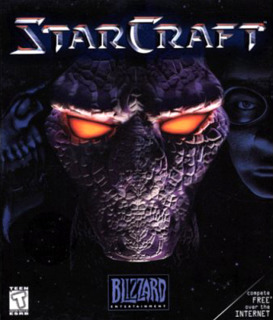Often dubbed as Blizzard's "other" franchise, Starcraft has cemented its fate as one of the best games in RTS history.
Released on April 1, 1998, Starcraft drew upon the inspiration of Warcraft II and Total Annihilation to pioneer a new standard on which all RTS's then were crafted upon. What Starcraft did was not completely mind blowing. Blizzard aimed to create a strategy game based on three completely differing factions. This seemed a novel idea considering their previous effort, Warcraft II, simply had two factions which (to a great extent) mirrored each other in units and strategy. With Starcraft, Blizzard crafted the 1)Terrans: a race of mechanized human beings left to survive and colonize on their own, the 2)Zergs: a race of parasitic invaders controlled by a totalitarian centralized "brain" or mind, and finally the 3)Protoss: a race of zealous warriors humbled in their honor and appreciation for battle and death.
The new precedent that Blizzard set was balance. For prior games, companies simply made each side equivalent, allowing for a complete but dull balance. Starcraft achieved balance between three completely different races and all were viable against each other in terms of Units and Strategy. What perhaps should be more noted is Blizzard's constant revisiting of the balance in the form of patches which they released periodically to the public.
The game featured three excellent campaigns featuring memorable heroes, fantastic level design, and a sheer and utter amount of polish on all aspects of the game. The story traces the foundation of the Terran empire and the insurgency of various Terran sects, the arrival and enslavement of the Terrans by the hands of the Zerg, and finally the sacrifice of Tassadar, of the Protoss, to ebb the flow of Zerg power.
The graphics and sound, although were not technically the most impressive, showed character and suited the needs of the game perfectly. Where upon the majority of the games themes are cacophonous and relatively negative, one needs the tacit humor that arrives from the mouths of the various units. The graphics showed the edge of 2D gaming, and still looks good in comparison to the 3D age of gaming.
What finally sealed Starcraft's destiny as one of the Greatest Games ever was the fun, varied, and free multi-player available on Blizzard's Battle.net Internet service. Whereas the campaign was the drawing point of the game, the multi-player was its sticking point. The online component included variants to the original game's formulae, tournament style battles, and an ever evolving ladder ranking system. All this worked in conjunction with the core of the game to create an excellent and viable product.
Starcraft was Blizzard's masterpiece. Whereas they gained the majority of their notoriety from the Warcraft series, Starcraft was the brainchild of Blizzard and is the culmination of everything great in Real-Time strategy gaming. Starcraft helped cement Blizzard's reputation as one of the greatest developers in the world.
(***Note: this review did not receive a 10 because of Blizzard's Warcraft III, which in my opinion, has even surpassed Starcraft and taken the mantle as the definitive RTS game ***)

